Watch Folders Tab
Reading time ~13 minutes
This tab allows configuring watch folders that will monitor transcoding tasks.
To add a new watch folder, press the "+" button. Select one of the following task types from the list that appears:
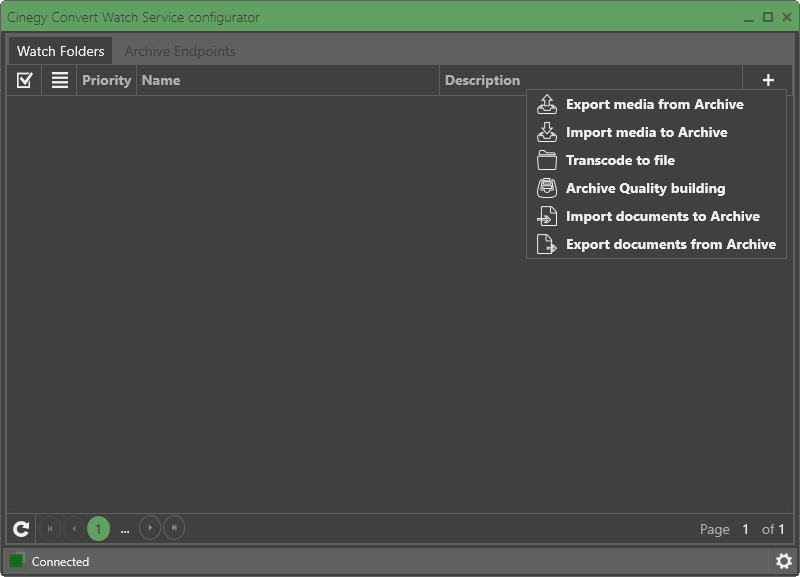
Currently, six task types are available for configuration in the Cinegy Convert Watch Service:
Export Media from Archive
To automate the repetitive export of media from Cinegy Archive tasks, Cinegy Archive job drop targets are used. A job drop target is a special node type displayed in the Cinegy Desktop user interface that allows export task submission. To submit a task, add the desired node(s) to the open job drop target container via drag-and-drop, or use the command "Send to job drop target" from the context menu. Cinegy Convert Export from Archive watch folders are designed to provide the connection between Cinegy Archive job drop targets and Cinegy Convert processing queues.
|
When the "Export media from Archive" task is added, it is necessary to configure it using the corresponding form: |
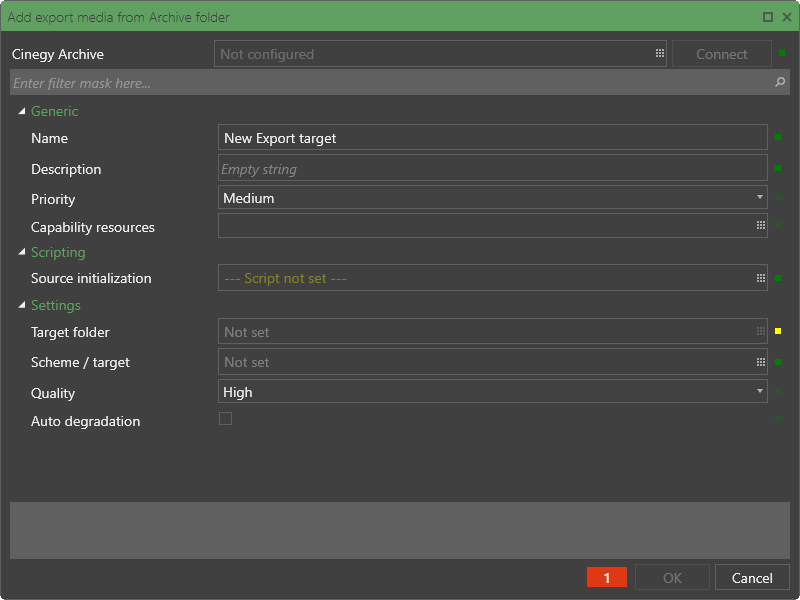
|
Important
|
Valid Cinegy Archive connection settings are required to define certain watch folder parameters. Read the CAS connection configuration description for details. |
|
Press the "Connect" button to establish the connection to the specified database. |
|
Once the connection is established successfully, it becomes replaced by the "Disconnect" button. Press this button in case you want to abort the connection. |
Further parameters are split into two groups:

The "Generic" group allows configuring the following settings:
-
Name – specify the export watch folder name.
-
Description – enter the export watch folder description if needed.
-
Priority – use the drop-down list to define high, medium, low, or lowest default task priority.
-
Capability resources – define the list of requirements to be met by the Cinegy Convert agent to be able to pick up tasks generated by the current watcher. For example, access to some special network share with restricted access can be defined as the "Capability resource" and assigned to the dedicated Cinegy Convert Agent Manager machines.
ImportantThe capability resources are added via the Cinegy Process Coordination Explorer. Refer to this article for detailed information about capability resource creation.
In the "Scripting" group you may define a preferable script to be called before source initialization either by entering it manually or exporting an already-made PowerShell script.
The following parameters should be configured in the "Settings" group:
-
Target folder – define the export job drop target folder in the Cinegy Archive database by pressing the
 button and selecting the required resource from the dialog that appears.
button and selecting the required resource from the dialog that appears. -
Scheme/target – specify the export scheme by pressing the
 button and selecting the required resource from the dialog that appears.
button and selecting the required resource from the dialog that appears. -
Quality – select the desired media quality from the drop-down list.
-
Auto degradation – select the checkbox to enable switching to the next available quality.
Having defined all the parameters, press "OK".
Metadata Override
While editing the watch folder configuration, it is possible to override metadata settings from the target scheme selected for it. Press the  button on the right to the "Scheme/target" field and select the "Edit" command:
button on the right to the "Scheme/target" field and select the "Edit" command:

The following dialog appears:
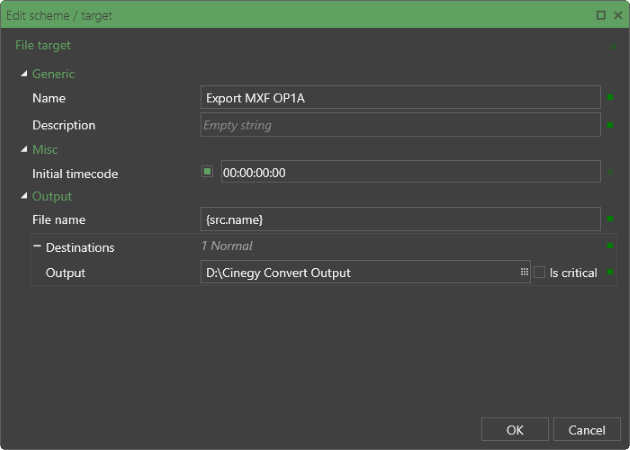
Here you can change the values of metadata fields required for this watch folder.
Import Media to Archive
|
Having added the "Import media to Archive" task, configure it using the corresponding form that appears. |
Similar to the export from archive task type configuration, parameters are split into groups:
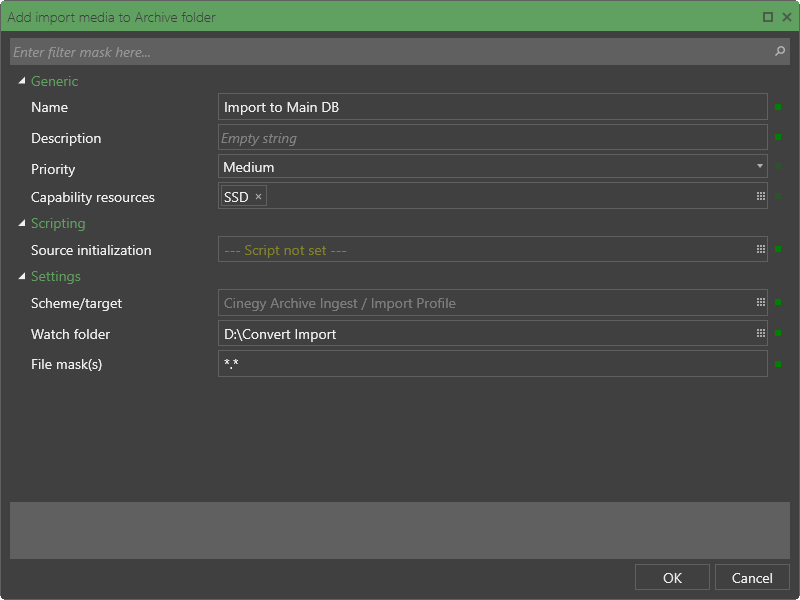
The "Generic" group allows configuring the following settings:
-
Name – specify the import task watch folder name.
-
Description – enter the import watch folder description if needed.
-
Priority – use the drop-down list to define high, medium, low, or lowest default task priority.
-
Capability resources – define the list of requirements to be met by the Cinegy Convert agent to be able to pick up tasks generated by the current watcher. For example, access to some special network share with restricted access can be defined as a "Capability resource" and assigned to the dedicated Cinegy Convert Agent Manager machines.
ImportantThe capability resources are added via the Cinegy Process Coordination Explorer. Refer to this article for detailed information about the creation of capability resources.
In the "Scripting" group you may define a preferable script to be called before source initialization either by entering it manually or exporting an already-made PowerShell script.
The following parameters should be configured in the "Settings" group:
-
Scheme/target – specify the import scheme by pressing the
 button and selecting the required resource from the dialog that appears.
button and selecting the required resource from the dialog that appears. -
Watch folder – define the import folder on the local PC or in a network share by pressing the
 button. Select the desired folder or make a new one and press "Select Folder".
button. Select the desired folder or make a new one and press "Select Folder". -
File mask(s) – define the specific file types the watch folder will identify for processing. Multiple masks can be specified with
;used as a separator (e.g., *.avi; *.mxf).
Having defined all the parameters, press "OK".
Metadata Override
While editing the watch folder configuration, it is possible to override metadata settings from the target scheme selected for it. Press the  button on the right to the "Scheme/target" field and select the "Edit" command:
button on the right to the "Scheme/target" field and select the "Edit" command:

The following dialog appears, allowing you to change the values of the metadata fields required for this watch folder. To make changes to the database-related fields, establish the connection by pressing the "Connect" button.
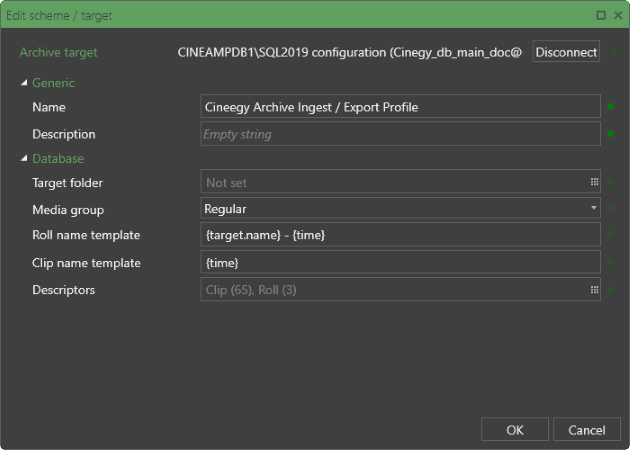
Pressing the  button in the "Descriptors" field will launch the dialog for editing descriptors for master clips:
button in the "Descriptors" field will launch the dialog for editing descriptors for master clips:
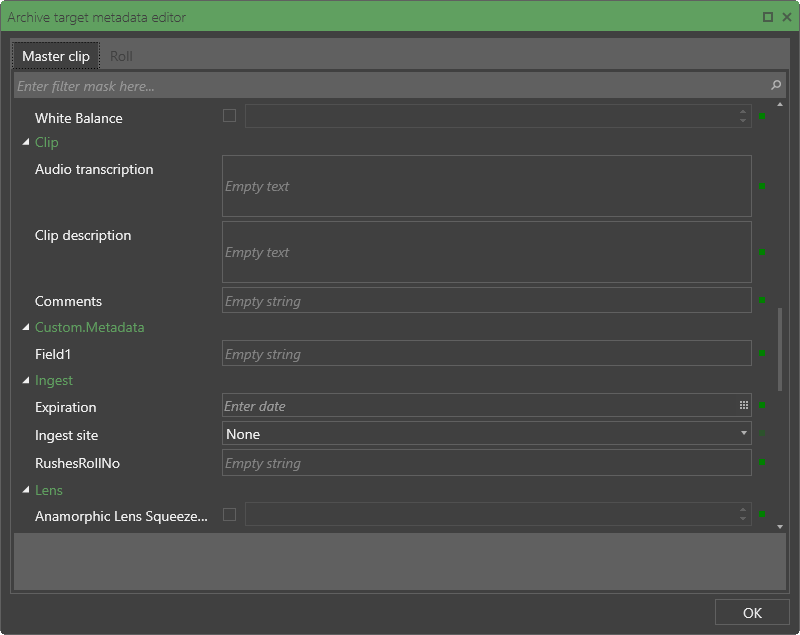
The Rolls descriptors can also be edited on the dedicated tab:
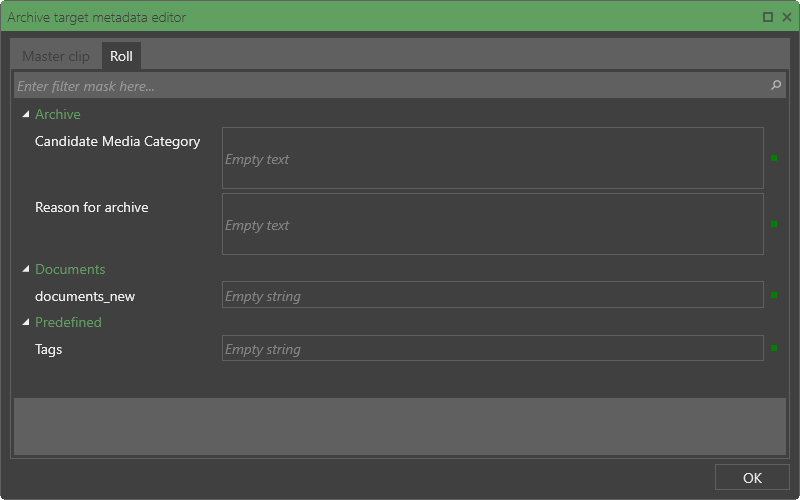
Transcode to File
|
The transcoding task type is used for standalone mode without connection to the database required. These tasks perform transcoding of a file encoded by one codec to another codec or into another wrapper, or both, or direct transcoding – repacking into another wrapper without transcoding. |
The transcoding task type configuration consists of the following parameters that should be set up identically to the other tasks described above.

The "Generic" group parameters are:
-
Name – specify the transcoding task watch folder name.
-
Description – enter the description if needed.
-
Priority – use the drop-down list to define high, medium, low, or lowest default task priority.
-
Capability resources – define the list of requirements to be met by the Cinegy Convert agent to be able to pick up tasks generated by the current watcher. For example, access to some special network share with restricted access can be defined as a "Capability resource" and assigned to the dedicated Cinegy Convert Agent Manager machines.
ImportantThe capability resources are added via the Cinegy Process Coordination Explorer. Refer to this article for detailed information about the creation of capability resources.
In the "Scripting" group you may define a preferable script to be called before source initialization either by entering it manually or exporting an already-made PowerShell script.
The "Settings" group parameters are:
-
Scheme/target – specify the transcoding scheme by pressing the
 button and selecting the required resource from the dialog that appears.
button and selecting the required resource from the dialog that appears. -
Watch folder – define the folder to be monitored on the local PC or in a network share by pressing the
 button and selecting the required location from the dialog that appears.
button and selecting the required location from the dialog that appears. -
File mask(s) – define the specific file types the watch folder will identify for processing. Multiple masks can be specified with
;used as a separator (e.g., *.avi;*.mxf).
Metadata Override
While editing the watch folder configuration, it is possible to override metadata settings from the target scheme selected for it. Press the  button on the right to the "Scheme/target" field and select the "Edit" command:
button on the right to the "Scheme/target" field and select the "Edit" command:

The following dialog appears:
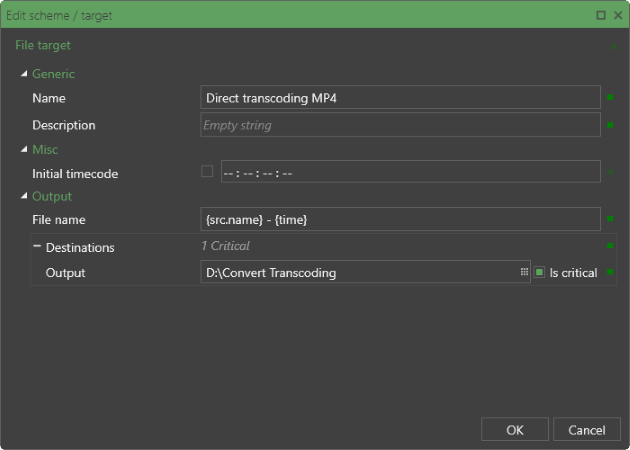
Here you can change the values of the metadata fields required for this watch folder.
Archive Quality Building
|
The Archive Quality building task type is used for the automatic creation of non-existent qualities from the selected quality Cinegy Archive Roll quality. |
The Archive Quality Building task type configuration consists of the following parameters that should be set up identically to the other tasks described above.
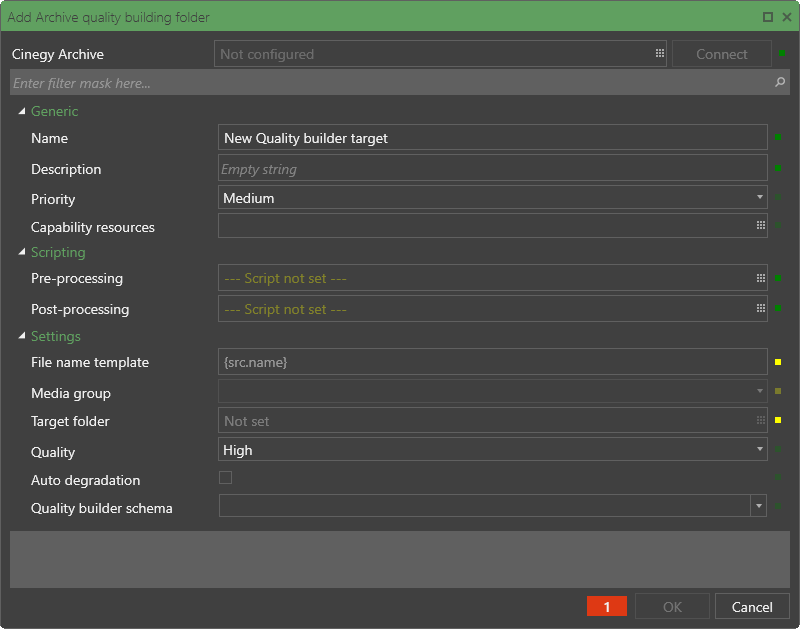
|
Important
|
Valid Cinegy Archive connection settings are required to define certain watch folder parameters. Read the CAS connection configuration description for details. |
The "Generic" group parameters are:
-
Name – specify the Archive Quality building task watch folder name.
-
Description – enter the description if needed.
-
Priority – use the drop-down list to define high, medium, low, or lowest default task priority.
-
Capability resources – define the list of requirements to be met by the Cinegy Convert agent to be able to pick up tasks generated by the current watcher. For example, access to some special network share with restricted access can be defined as a "Capability resource" and assigned to the dedicated Cinegy Convert Agent Manager machines.
ImportantThe capability resources are added via the Cinegy Process Coordination Explorer. Refer to this article for detailed information about the creation of capability resources.
In the "Scripting" group you may define preferable Pre- and Post-processing scripts either by entering them manually or exporting already-made PowerShell scripts.
The "Settings" group parameters are:
-
File name template – define the file naming template to be used in Cinegy Archive Quality Building jobs. This field is mandatory. Its default value is
{src.name}. Macros can be used in this field.NotePlease note that a unique ID will be automatically appended to the file name to avoid potential clashes with the existing files on the disk.
-
Media group – specify the Cinegy Archive media group to store document files.
-
Target folder – specify the Cinegy Archive Quality Building job drop target by pressing the
 button and selecting the required resource from the dialog that appears.
button and selecting the required resource from the dialog that appears. -
Quality – select the desired media quality from the drop-down list.
-
Auto degradation – select the checkbox to enable switching to the next available quality.
-
Quality builder schema – select one or several specific TV formats from the drop-down list to use them for quality building.
Having defined the required TV format, you should specify the qualities that will be created in the corresponding Roll. To do this, press the
 button and select the required command:
button and select the required command: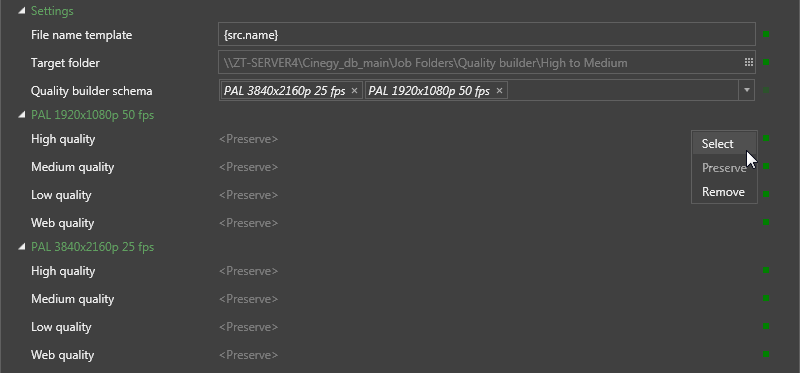
-
Select – select the profile for the corresponding quality creation from the Cinegy PCS resources list in the dialog that appears.
-
Preserve – use this option to preserve the existing Roll quality, if any.
-
Remove – use this option to remove the existing Roll quality, if any.
NoteThe "Preserve" option is selected for all qualities by default. NoteThe quality building parameters should be specified for each selected TV format separately in the respective settings section.
-
Import Documents to Archive
|
The "Import documents to Archive" task type is used for the automatic copying of pictures, folders, and other document files from the network storage into the Archive and registering them there. |
This task type configuration consists of the following parameters that should be set up identically to the other tasks described above.
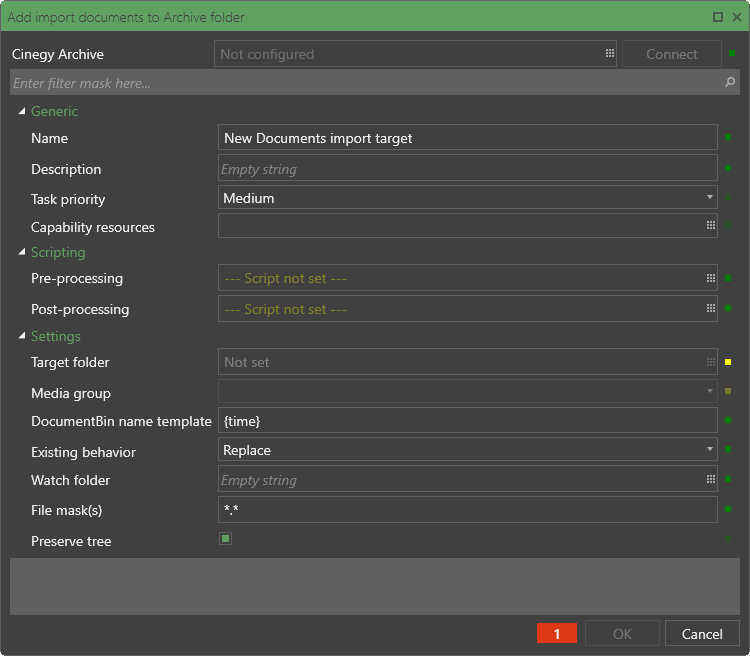
The "Generic" group allows configuring the following settings:
-
Name – specify the name of the network share to be monitored.
-
Description – enter the network share description if needed.
-
Task priority – use the drop-down list to define the lowest, low, medium, or high default task priority.
-
Capability resources – define the list of requirements to be met by the Cinegy Convert agent to be able to pick up tasks generated by the current watcher. For example, access to some special network share with restricted access can be defined as a "Capability resource" and assigned to the dedicated Cinegy Convert Agent Manager machines.
ImportantThe capability resources are added via the Cinegy Process Coordination Explorer. Refer to this article for detailed information about the creation of capability resources.
In the "Scripting" group you may define preferable Pre- and Post-processing scripts either by entering them manually or exporting already-made PowerShell scripts.
The "Settings" group parameters are:
-
Target folder – define the folder in Archive where documents will be imported.
-
Media group – specify the Cinegy Archive media group to store document files.
-
DocumentBin name template – specify the DocumentBin name to be used for importing.
ImportantFor the DocumentBin name template, you can use the macros to apply naming automation. Refer to the Macros article for details. -
Existing behavior – from the drop-down list select the way existing conflicts of documents are resolved:
-
Skip – Document import is skipped;
-
Replace – a document file is replaced with a new one;
-
Rename – a new document is renamed as
[original_name] (N).[original_ext], where N is the next non-existing integer starting from 1; -
Fail – the import task is failed.
-
-
Watch folder – define the folder to be monitored on the local PC or in a network share. In case any document files are located within the watch folder the Document Bin is opened or created with the name from the DocumentBin name template.
-
File mask(s) – define the specific file types the watch folder will identify for processing. Multiple masks can be specified with
;used as a separator (e.g., *.doc;*.png). -
Preserve tree – specify whether the folder tree should be preserved when importing documents. When the "Preserve tree" is enabled, the folders are scanned recursively and all documents are imported. For each folder, a corresponding one is created in Archive.
Export Documents from Archive
|
The "Export documents from Archive" task type is used for exporting Folders, DocumentBins, and Documents. |
The "Export documents from Archive" task type configuration consists of the following parameters that should be set up in the following groups:
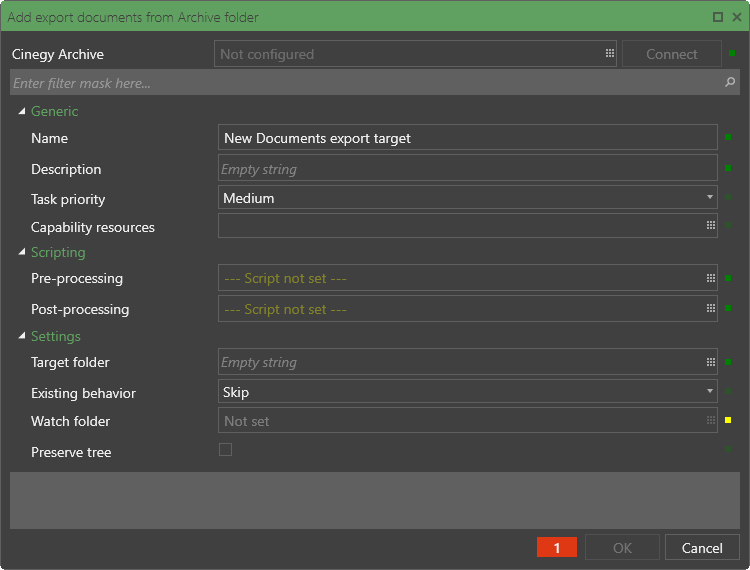
In the "Generic" group configure the following settings:
-
Name – specify the name of the task to be monitored.
-
Description – enter the task description if needed.
-
Task priority – use the drop-down list to define the lowest, low, medium, or high default task priority.
-
Capability resources – define the list of requirements to be met by the Cinegy Convert agent to be able to pick up tasks generated by the current watcher. For example, access to some special network share with restricted access can be defined as a "Capability resource" and assigned to the dedicated Cinegy Convert Agent Manager machines.
ImportantThe capability resources are added via the Cinegy Process Coordination Explorer. Refer to this article for detailed information about the creation of capability resources.
In the "Scripting" group you may define Pre- and Post-processing scripts, if available.
The "Settings" group parameters are:
-
Target folder – define the network share that will be used as a root. When a Document is provided as a job subject, the corresponding document file is copied to the Target Folder. When a Document Bin or a Folder is provided as a job subject, in case the Preserve tree option is set, the folder named the same as the DocumentBin or the Folder is created in the Target Folder and used as the target, each child document is copied to the Target folder.
-
Existing behavior – from the drop-down list select the way existing conflicts of documents are resolved:
-
Skip – Document export is skipped;
-
Replace – the file will be replaced with a new one;
-
Rename – the new file will be renamed as
[original_name] (N).[original_ext], where N is the next non-existing integer starting from 1; -
Fail – the export task should be failed.
-
-
Watch folder – define the Cinegy Archive job drop folder to be monitored for new tasks to be monitored by pressing the
 button and selecting the required location from the dialog that appears.
button and selecting the required location from the dialog that appears. -
Preserve tree – specify whether the folder tree should be preserved when exporting documents.






